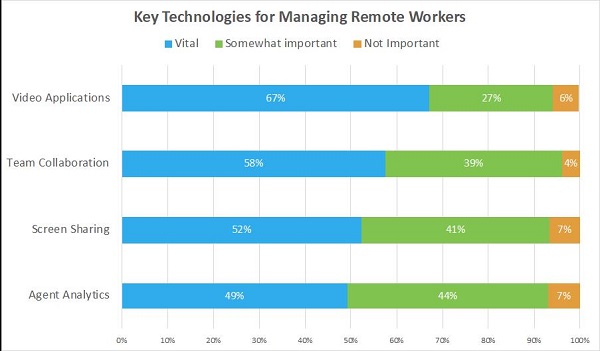Though many customer experience (CX) leaders assumed the pandemic workplace changes would be temporary, those changes became a catalyst for discussions around redesigning the contact center to improve both agent and customer experiences.
Prior to shelter-in-place orders starting in March 2020, many CX leaders wouldn’t have even considered allowing agents to work from home. Now, those same leaders are discovering benefits to remote agents — and concerns about technology performance in home offices are largely muted.
As of late 2020, 70% of organizations had agents working from home. Moving forward, only 7.6% have made a firm decision to fully return their agents to the office once the pandemic subsides, while 56.8% have decided to continue allowing work from home, either full- or part-time. The remainder (36.5%) is still evaluating, according to Metrigy’s “Customer Engagement Transformation: 2020-21 Research Study” of 700 global organizations.
The New CX Workplace
So, what will the new CX workplace look like? Four scenarios characterize those organizations that already have decided (the balance is still evaluating):
- Some agents will work from home full time; others will work at the contact center full time (23.3%). With this approach, companies can hire agents in remote (and potentially lower-cost) geographies. They can also have some agents working from home to keep the company prepared for future disasters. Meanwhile, agents will work at the contact center facility to receive hands-on coaching and also help each other with challenging customer questions. One agent from a financial-services company said, “When we were all in the office, I could just grab this person or that person who I knew had expertise in a certain area. Now, it’s harder to do that, so we can’t resolve customer issues as quickly.”
- All agents will work from home part time and go to the contact center part time (17.8%). Though this is the second-highest among all companies, it’s the approach of choice for our research success group — those who have the top improvements to their business metrics through the use of advanced CX technologies. In this scenario, all agents get the best of both worlds. They always have a functional home office, which helps the company for disaster planning and keeping employees healthy when agents feel under the weather but still are OK to work. And, they can go into the office for the aforementioned benefits.
- All agents will work from home indefinitely (15.7%). In this scenario, companies are eliminating their contact center commercial real-estate after determining their agents are performing as well or better from home offices, and customer satisfaction either improved or remained steady. They also tend to rely on collaboration and video technologies to manage their remote teams.
- No agents will continue to work from home (7.6%). This is the least popular option, but for some organizations, they must have people in a physical facility for industry-specific reasons. For example, they could be in a sensitive industry, such as defense contracting or financial services, and they do not want employees interacting with customers from home offices.
Remote Agent Management
Many supervisors struggled initially with managing remote teams, particularly those who were accustomed to managing 100% of their agents in the same physical space. Collaboration technologies have become a vital component to effective agent management. Research participants rely on video, team collaboration workspaces, screen sharing, and agent analytics to empower supervisors to effectively manage their remote agents.
In fact, two-thirds of companies said video applications are vital for remote management; without them, they simply would not be able to continue working remotely once the pandemic subsides. Video is key because it provides a personal touch in management by being able to see one another, but some companies also use it to coach agents who are using video to communicate with customers.
Team collaboration workspaces are vital for 58% of companies; CX leaders and agents use them to collaborate on timely customer issues, projects, training tips, and more. Meanwhile, 52% cite screen sharing as vital, with many using that capability to review agent analytics charts and tables during coaching sessions.
In addition to the enabling technologies, 49.2% of companies (and 72.7% of the research success group) also are working on comprehensive plans to reduce turnover rates, which inched up from 21% in 2019 to 23.1% in 2020. These plans include allowing agents to work more flexible hours (52.6%); increasing compensation (50%); adding agent analytics (48.2%), which supports additional supervisor coaching (37.6%); establishing a career path (43.6%); and adding gamification or competitions to improve performance (27.8%).
What’s great about these agent-focused programs is the business success they are generating. When measuring before-and-after results of their CX transformation projects, those with an agent retention initiative saw revenue increase by 53.6% vs. 35.3% for those without an initiative; and CX ratings improved by 39.5% with an initiative, vs. 25.3% without.
Key Technologies to Empower Remote Agents
Plenty of CX applications, products, and services can help agents perform better — ultimately resulting in higher customer satisfaction. Companies can’t buy every technology, so it’s important to start by identifying goals and mapping the technologies that will best help achieve them.
Broadly speaking, technologies that automate agent functions help reduce costs and improve agent productivity. Among our research participants, 43.4% automated agent functions, and 78% of those saw an increase in productivity — averaging 31.1%.
AI and analytics are two key technology categories that help to automate functions. Of course, AI comes in numerous flavors, ranging from intelligent routing to virtual assistants to language translation to image recognition. Now, 42% of companies are using some form of AI, but another 29.6% are planning to do so. More than half (56%) of companies are using analytics for CX.
Other key technologies to consider, specifically to empower remote agents, include:
- Collaboration applications, and the integration with the contact center platform (63%)
- Omnichannel capabilities to integrate new interaction channels (28%)
- AI-assisted self-service knowledge bases (36%)
- Workforce optimization applications (60%)
Lastly, don’t forget to equip the agent’s home office with reliable and secure Internet access, back-up landline or cellular phone service, a robust headset with noise cancellation, and advice on ergonomics, lighting, and privacy.











